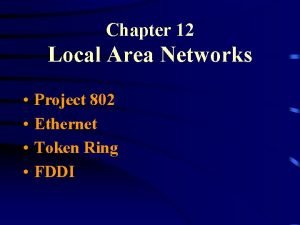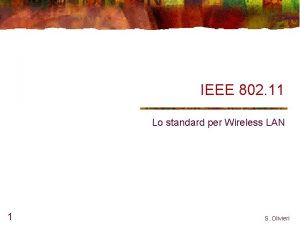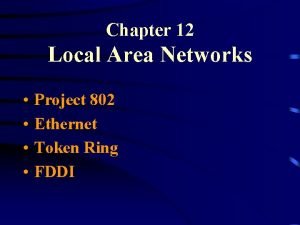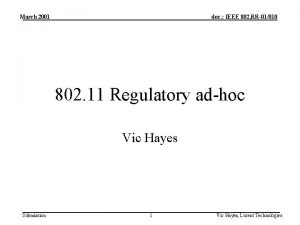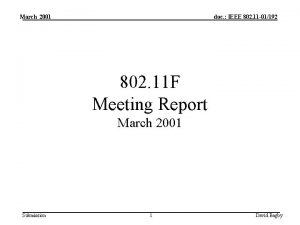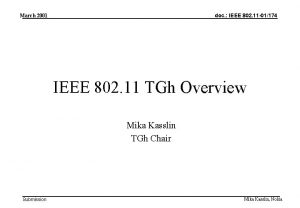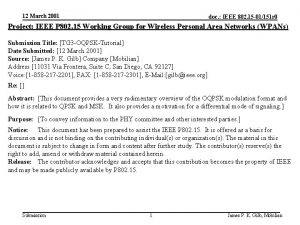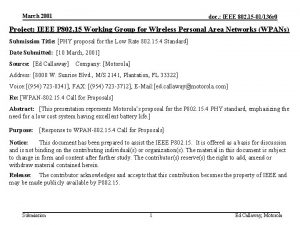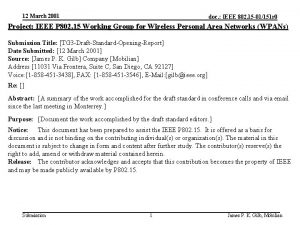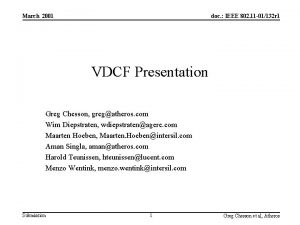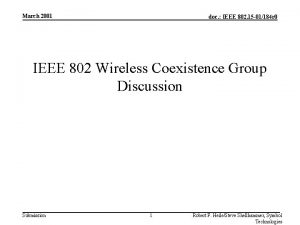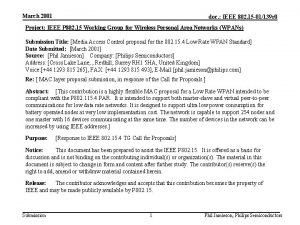March 2001 doc IEEE P 802 15 01125















- Slides: 15

March 2001 doc. : IEEE P 802. 15 -01/125 r 0 Project: IEEE P 802. 15 Working Group for Wireless Personal Area Networks (WPANs) Submission Title: [Media Access Control proposal for the 802. 15. 4 Low Rate WPAN Standard] Date Submitted: [March 2001] Source: [Carl R. Stevenson] Company: [Agere Systems] Address: [555 Union Boulevard, Room 22 W 214 EQ, Allentown, PA 18109] Voice: [(610) 712 -8514], FAX: [(610) 712 -4508], E-Mail: [carlstevenson@agere. com] Re: [ MAC layer proposal submission, in response of the Call for Proposals ] Abstract: [This contribution is a flexible MAC proposal for a Low Rate WPAN intended to be compliant with the P 802. 115. 4 PAR. It is intended to support both master-slave and peer-to-peer communications. It can also optionally support node-to-node relay capabilities to provide robust communications in a variety of propagation environments to meet the needs of a wide range of low data rate applications. In its basic form, it can support up to 255 nodes per PAN, but through address extension can be expanded to support a much larger number of nodes. ] Purpose: [Response to IEEE 802. 15. 4 TG Call for Proposals] Notice: This document has been prepared to assist the IEEE P 802. 15. It is offered as a basis for discussion and is not binding on the contributing individual(s) or organization(s). The material in this document is subject to change in form and content after further study. The contributor(s) reserve(s) the right to add, amend or withdraw material contained herein. Release: The contributor acknowledges and accepts that this contribution becomes the property of IEEE and may be made publicly available by P 802. 15. Submission 1 Carl R. Stevenson, Agere Systems

March 2001 doc. : IEEE P 802. 15 -01/125 r 0 MAC Layer Proposal Submission to the IEEE P 802. 15. 4 Low Rate WPAN Task Group Submission 2 Carl R. Stevenson, Agere Systems

March 2001 doc. : IEEE P 802. 15 -01/125 r 0 Who is ? • Formerly Lucent Technologies Microelectronics Group • In the process of spinning off as an independent semiconductor company • Extensive experience in communications IC design, DSPs, and wireless systems design Submission 3 Carl R. Stevenson, Agere Systems

March 2001 doc. : IEEE P 802. 15 -01/125 r 0 Description of MAC Layer Proposal (actually a MAC + LLC + at this point) • System Operation – Half-duplex TDMA/CSMA-CA DAMA/Contention Based Protocol • • • Submission Network(s) controlled by master unit(s) Beacon from master defines TDMA frame structure p-persistent slotted aloha CSMA-CA reservation request slots Dynamic bandwidth allocations for time-sensitive traffic p-persistent slotted aloha CSMA-CA contention access slots Supports time-sensitive and asynchronous traffic through mix of assigned bandwidth and contention access Supports master-slave and peer-peer communications Possible for slaves to participate in < 1 network Possible to have gateways/portals to other dissimilar networks Promotes power efficiency through sleep modes 4 Carl R. Stevenson, Agere Systems

March 2001 doc. : IEEE P 802. 15 -01/125 r 0 HDLC-like Packet Structure Supports Protocols • Based on existing ISO/IEEE/other standards • Some SDL exists for similar protocols, which may be reusable with little modification • Transparent to data content – Allows encapsulation of higher layer protocols between link layer DSAPs – Does not impose data type dependencies – Can transport encrypted payloads, if desirable • Small code size and CPU load possible – Amateur Packet Radio implementations with nearly comparable complexity use 8 -bit CPUs & 32 k bytes of code – Additional complexity for TDMA and other features should not be excessive Submission 5 Carl R. Stevenson, Agere Systems

March 2001 doc. : IEEE P 802. 15 -01/125 r 0 Variable Length Packets Submission 6 Carl R. Stevenson, Agere Systems

March 2001 doc. : IEEE P 802. 15 -01/125 r 0 Dynamically-assigned Frame Structure Submission 7 Carl R. Stevenson, Agere Systems

March 2001 doc. : IEEE P 802. 15 -01/125 r 0 Frame Structure Can Vary Frame to Efficiently Handle a Mix of Traffic Types Submission 8 Carl R. Stevenson, Agere Systems

March 2001 doc. : IEEE P 802. 15 -01/125 r 0 Slaves Can Be Moved to Other Channels Temporarily if Traffic Makes it Desirable Submission 9 Carl R. Stevenson, Agere Systems

March 2001 doc. : IEEE P 802. 15 -01/125 r 0 MAC Implementation Concept (actually a MAC + LLC + at this point) • Substantially “Soft” MAC/LLC Implementation – – – – – Submission Proposal estimates based on synthesizable ARM 7 core Frame buffers included in PHY size/power estimates 4 k Bytes RAM estimated for data 128 k bytes ROM estimated for MAC/LLC/Application code RAM and ROM sizes can be optimized as requirements become more clear Peripherals include 16 bits of GPIO & RTC (other options) Clock circuitry for scaleable clock rates including very low power ring oscillator for use during deep sleep modes Ring oscillator calibrated to master crystal oscillator to minimize clock drift during sleep modes Minimal additional support logic Application code space and CPU cycles available 10 Carl R. Stevenson, Agere Systems

March 2001 doc. : IEEE P 802. 15 -01/125 r 0 Power Mangement and Battery Life • Masters should generally be line-powered or have << battery capacity than slaves – Facilitates efficient, reliable network control – Assures beacons are available regularly for slaves – Power drain due to processing load becomes insignificant • Slaves can have extended operating life on modest batteries – Slave devices make use of low power modes – Master can command slaves into deep sleep mode for multiple superframe intervals to conserve battery power in slave devices which can tolerate latency – RSSI & link quality based TX power management possible – Battery requirements/battery life depend on traffic load, TX power, and latency tolerance of a device Submission 11 Carl R. Stevenson, Agere Systems

March 2001 doc. : IEEE P 802. 15 -01/125 r 0 Die Size Estimate - Total Solution (PHY + MAC + Misc) Submission 12 Carl R. Stevenson, Agere Systems

March 2001 doc. : IEEE P 802. 15 -01/125 r 0 Power Consumption Estimate - Total Solution (PHY + MAC + Misc) Submission 13 Carl R. Stevenson, Agere Systems

March 2001 doc. : IEEE P 802. 15 -01/125 r 0 Self-ranking in Comparison to Criteria • Awaiting completion of Criteria Document • Will complete self-ranking matrix in a timely manner when Criteria Document and matrix worksheet become available Submission 14 Carl R. Stevenson, Agere Systems

March 2001 doc. : IEEE P 802. 15 -01/125 r 0 Thank you for your attention. Any questions? Submission 15 Carl R. Stevenson, Agere Systems












